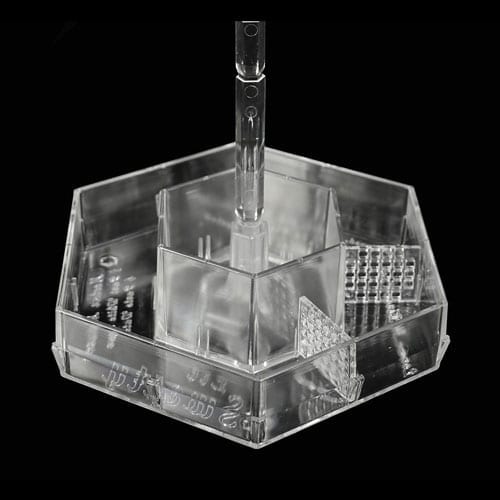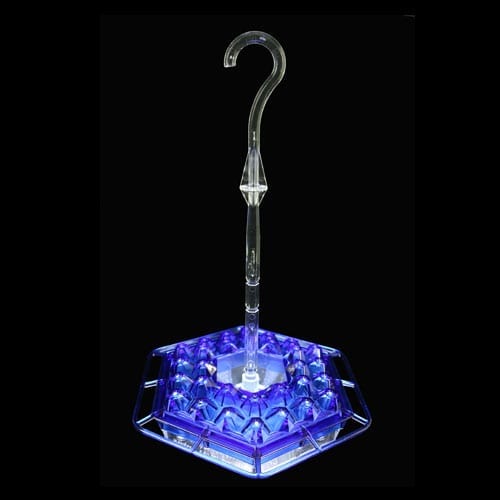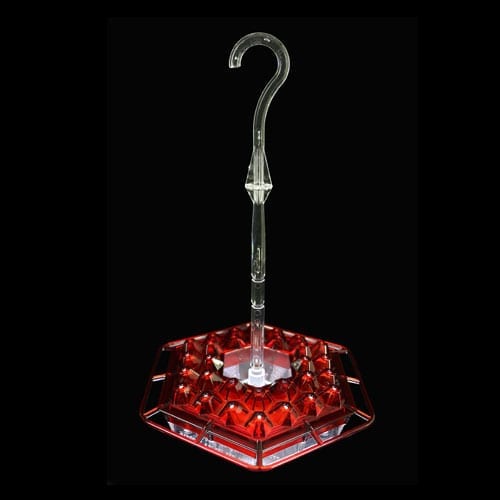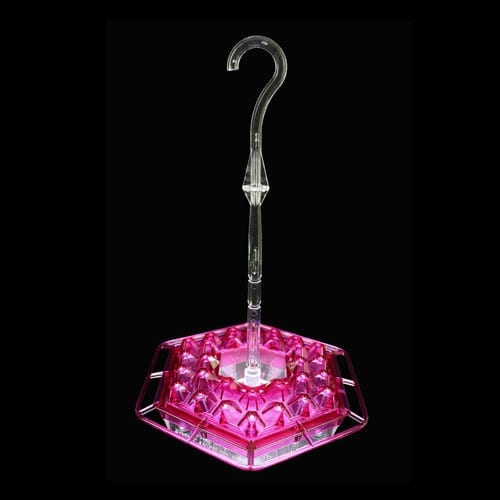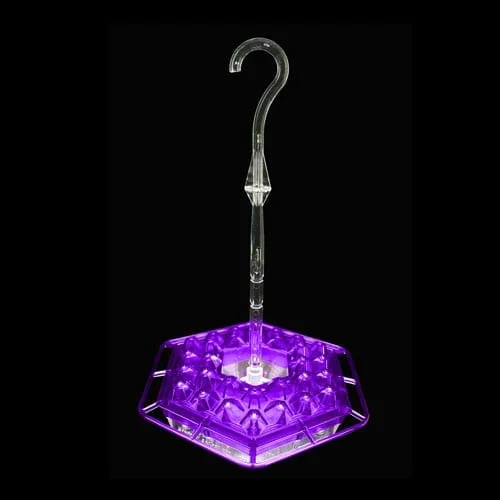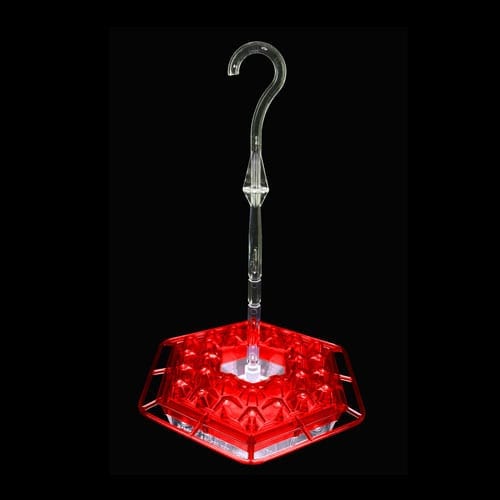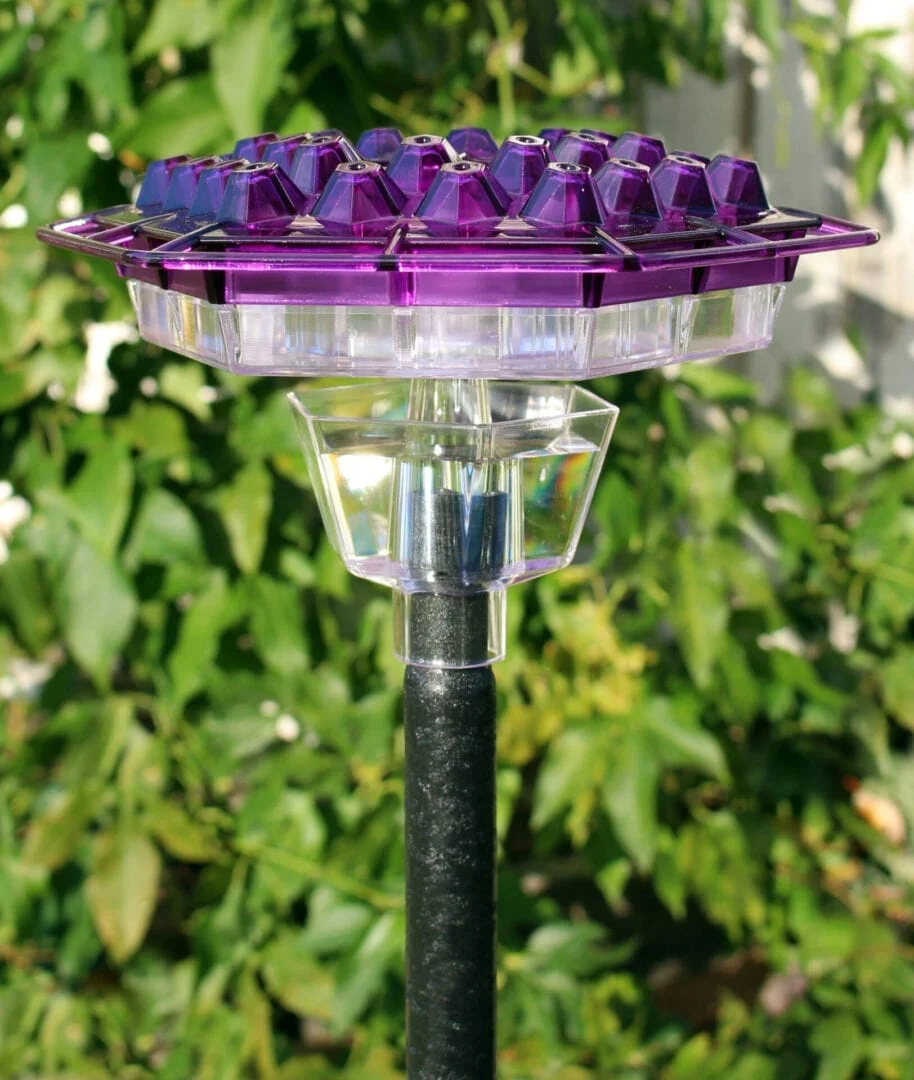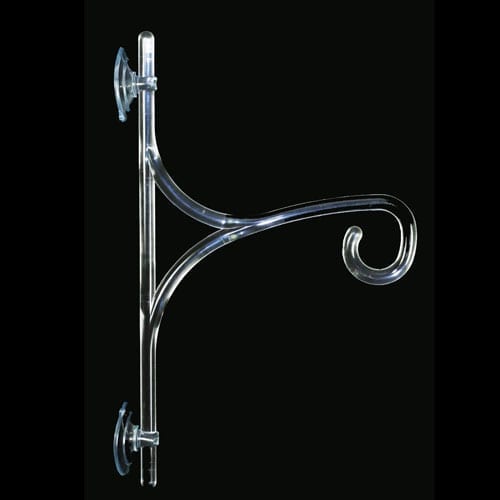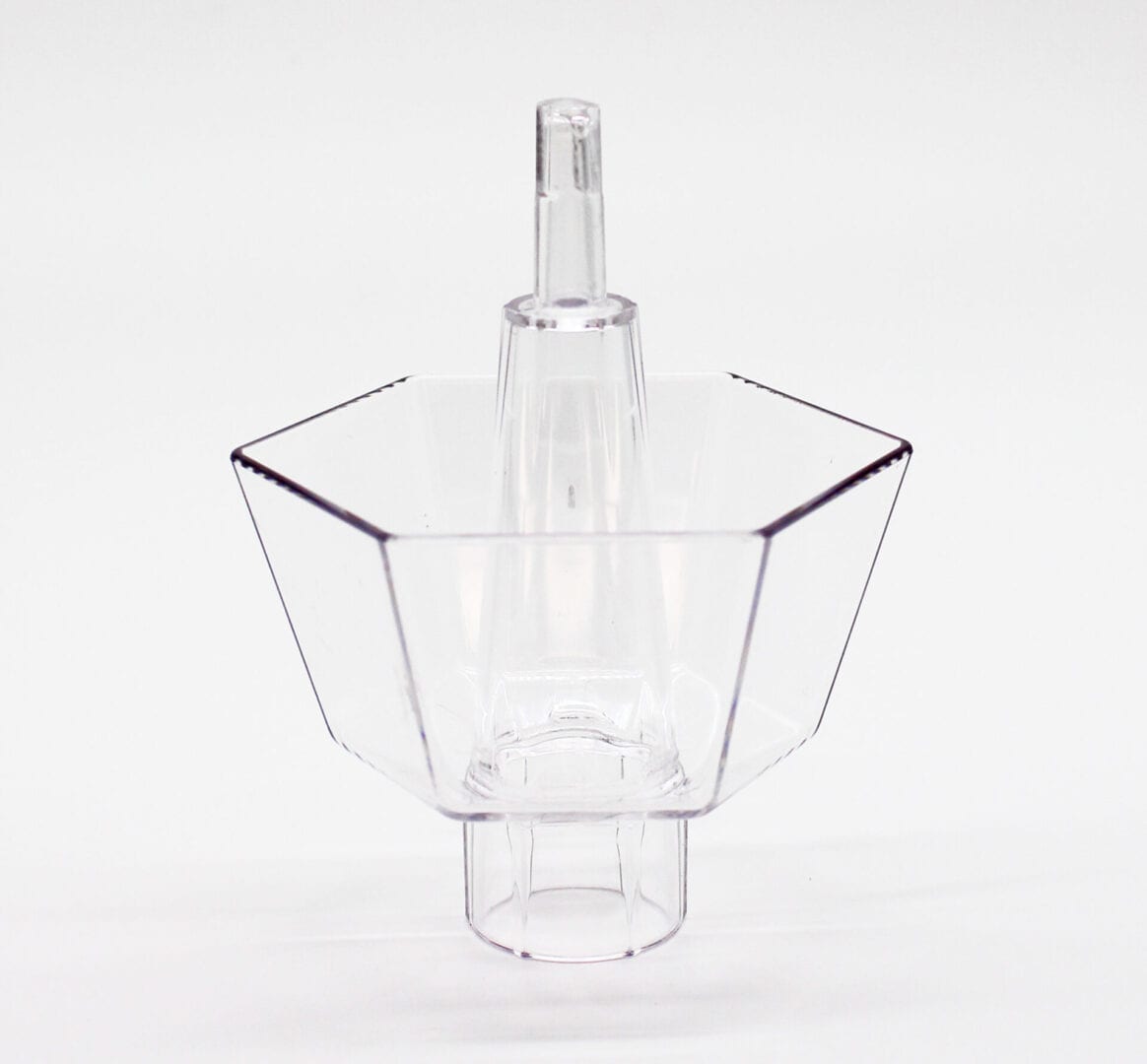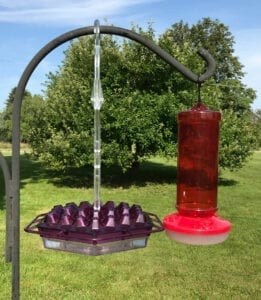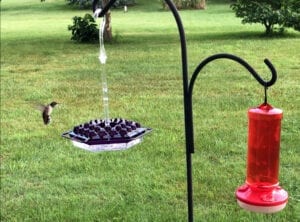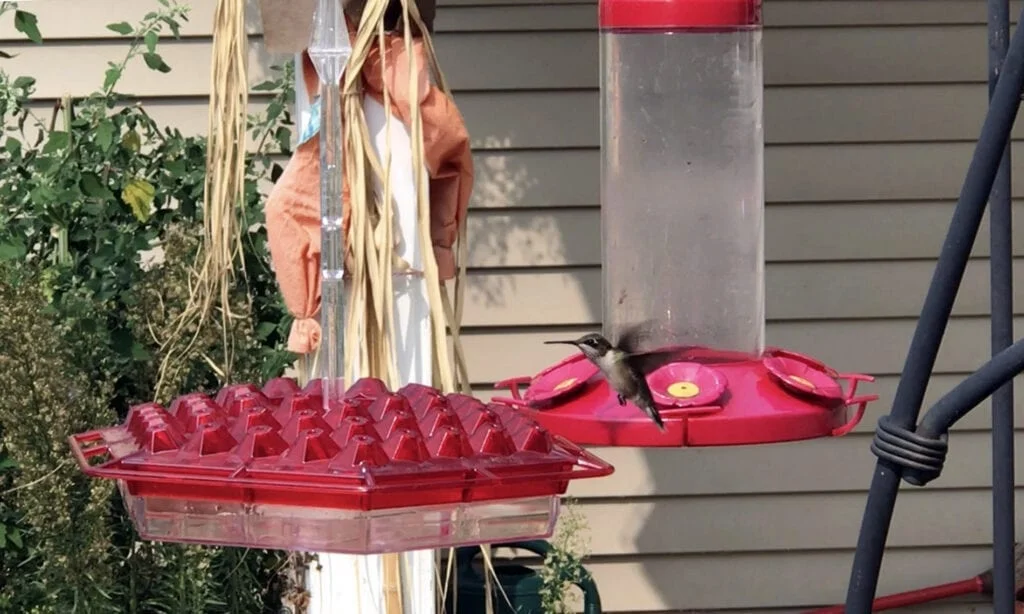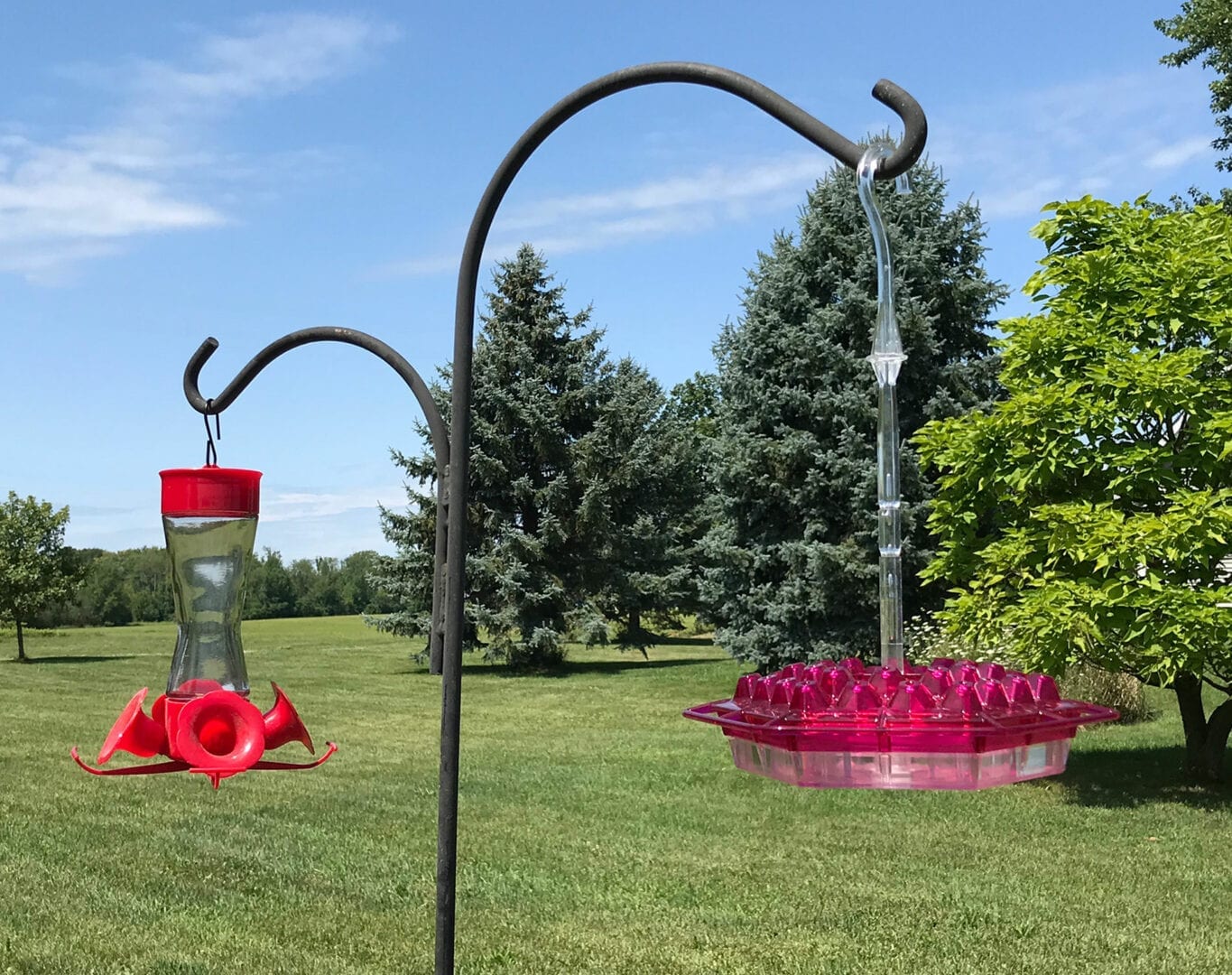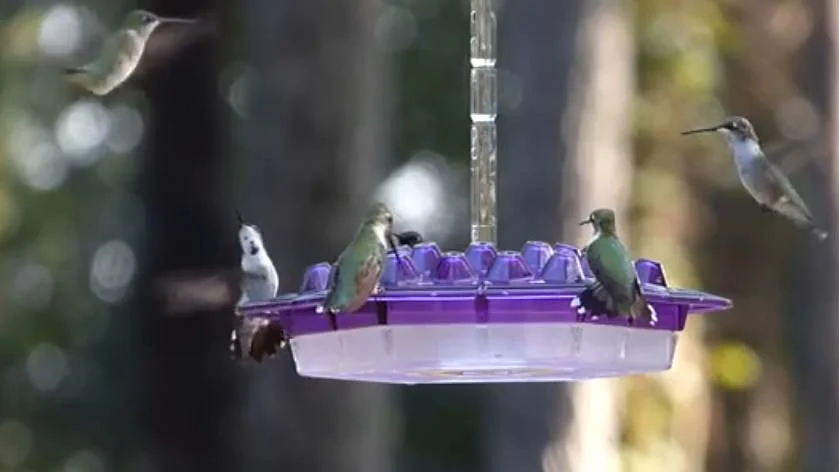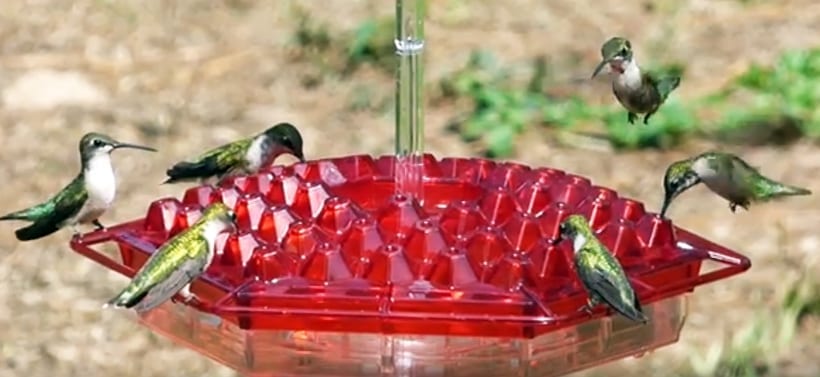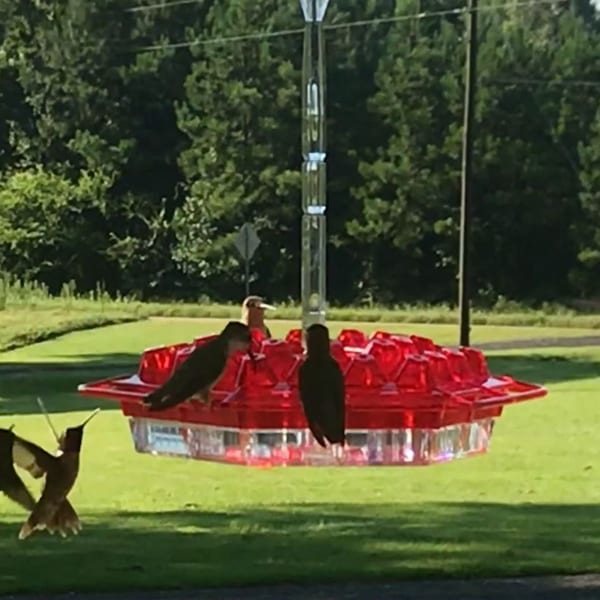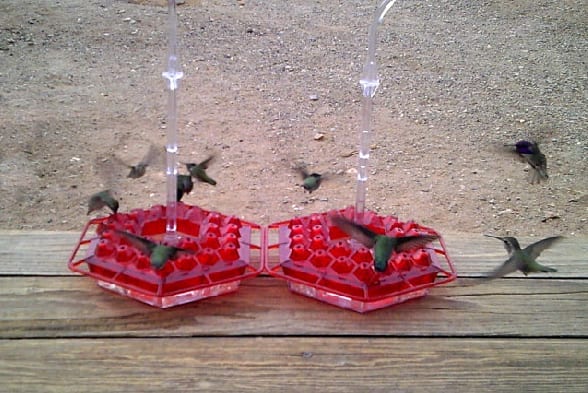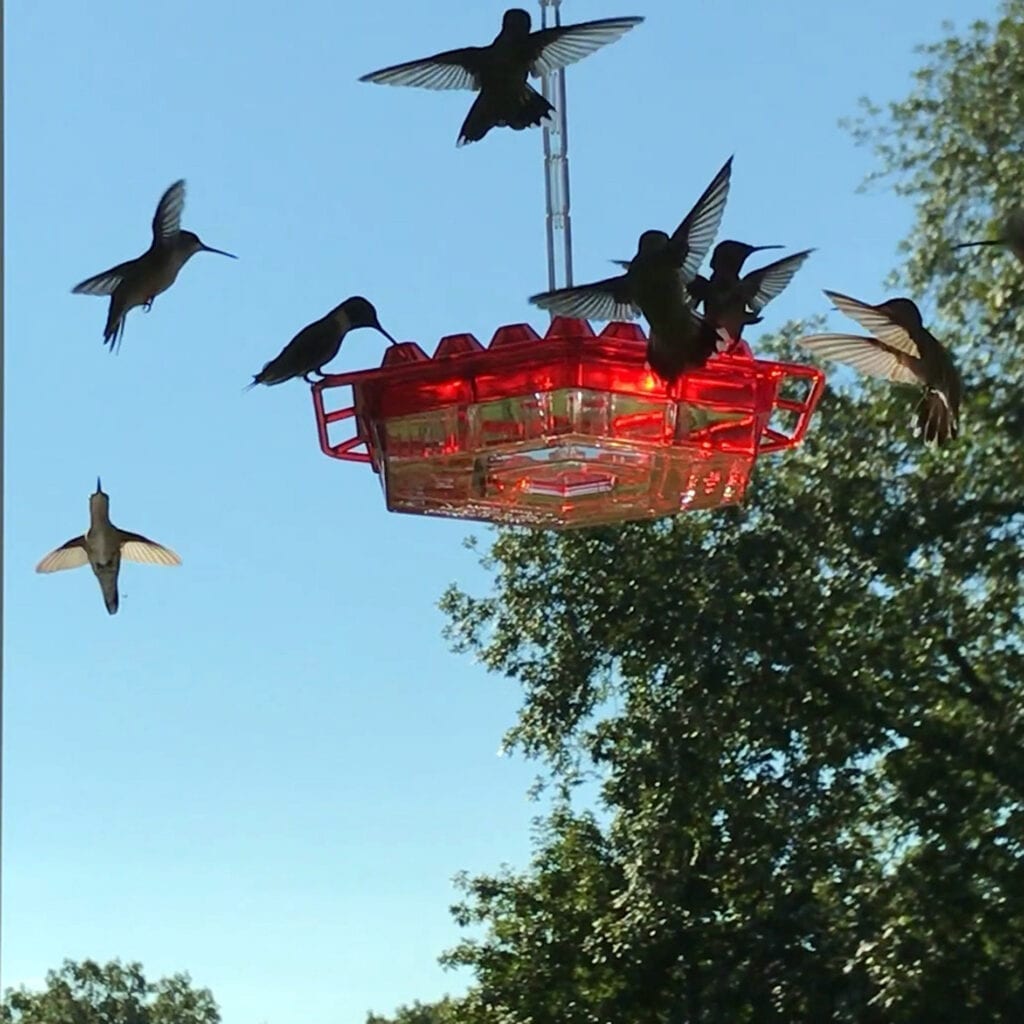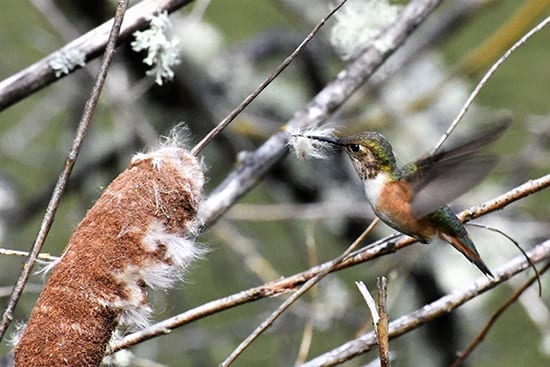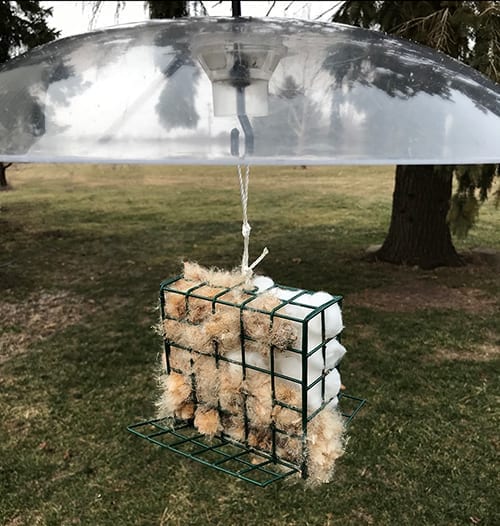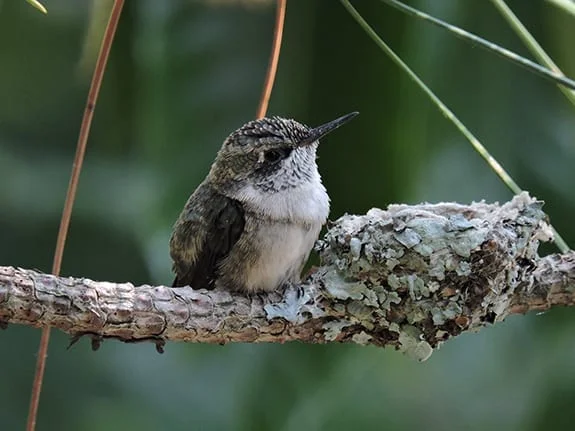ATTRACTING Hummingbirds 101...
The best way to attract hummingbirds is also the easiest
Get their attention with flowers
You don't need to re-landscape your yard. You don't even need a flower garden. Treat yourself to a big, beautiful hanging basket of flowers. On a double shepherd’s hook, hang your flowers on one side and the hummingbird feeder on the other. That's it. Hummingbirds can see flowers a long way off, like a bright, 'EAT HERE' billboard, only prettier. They'll zero in on the flowers and, with the feeder hanging next to the flowers, they'll predictably give the feeder a try. It works so well, it seems like cheating.
But which flowers?? The best way is, again, the easiest - Go to your local nursery; The mom & pop nursery - not the big box store or grocery store. Tell them you want to attract hummingbirds. They're the experts. They have hummingbirds there and know exactly what hummingbirds like, as well as what flowers will do best in your yard.
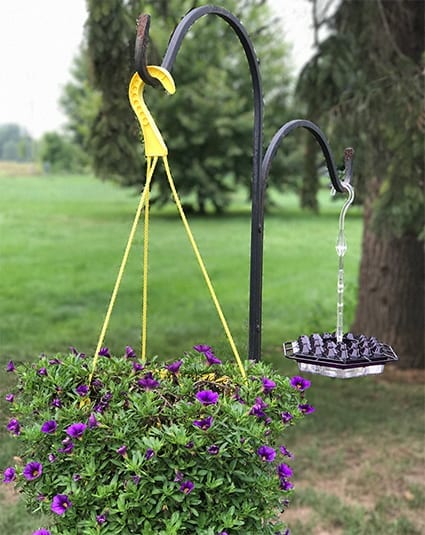
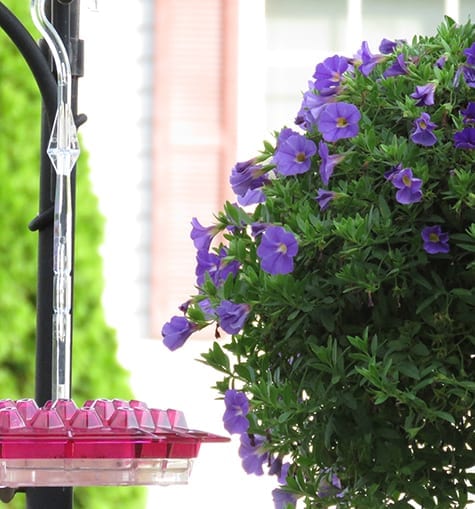
Make YOUR yard their favorite yard:
Get their attention and keep it.
If you’ve got perennials that hummingbirds like, all the better! Hummingbirds will never pass up a cornucopia of flowers. But, if you want to keep those hummingbirds around all Summer, add a hanging basket or two. Annuals bloom all summer long so are a great supplement when your perennials aren't blooming. For more information about which flowers are best for hummingbirds, this Spring we'll go right to an experienced grower and find out which flowers seem to work best. See our future blog, ATTRACT MORE HUMMINGBIRDS.
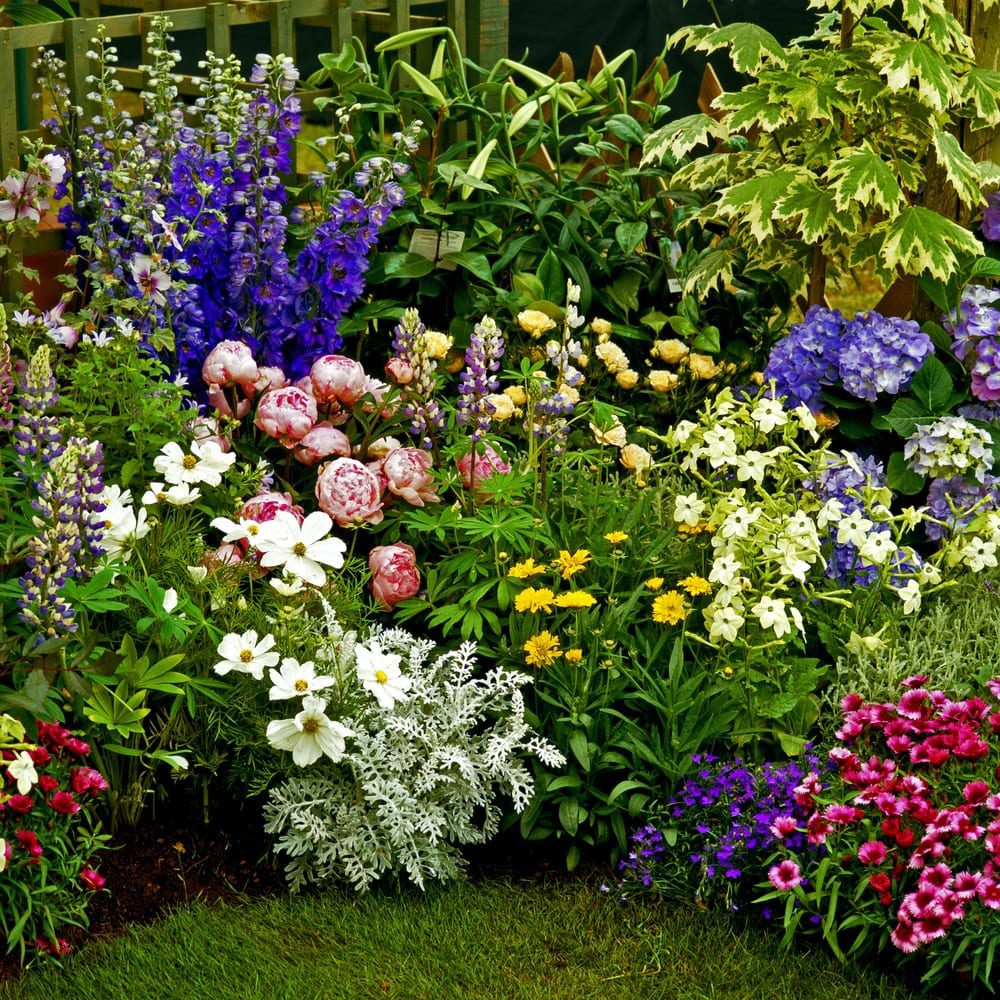
SWITCHING to a New Feeder:
Hummingbirds return to the same yard, and feeders, every year. They know your feeder. When you hang out a new, different feeder, YOU know it's a hummingbird feeder but your hummingbirds don't know that it's anything more than new yard decoration. To switch your hummingbirds to a new feeder, use the tried and true “Bait & Switch” technique...
Hang your old feeder, in it's original location. BUT... make sure it's completely EMPTY! Then, hang your new feeder next to it, FULL of fresh nectar.
This way, your hummingbirds, seeing their old, familiar feeder, will not fail to stop at your yard. But, finding that feeder empty, they predictably start checking around for another food source. This works very well because it's actually the way they naturally feed from flowers. Each bloom only has a little nectar each day so, when they finish one bloom, they move to the bloom next to it. When they finish with one plant, they start on the plant next to it. Be patient! Most hummingbirds switch in a day or two but some can take a week or more. You may notice that the males tend to be slower to switch. Hm...
NOTE: For the first of the season, it's a good idea to put out your old feeder, filled with nectar until you think all of your hummingbirds are back - or until dependably warmish weather. Their migration is very difficult and you'll want them to have a couple days to bulk up again. Then go ahead with the Bait & Switch.
There's more, in depth, details about switching feeders in our BLOG post, How to Switch Your Hummingbirds to a New Feeder.
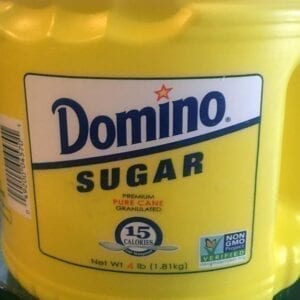
Use the BEST food
Another secret to keeping your hummingbirds loyal is to use pure CANE sugar. Not all granulated sugar is cane sugar. Also, never use any sugar with a brownish tint. Learn why, and lots of stuff you probably didn't know about different sugars and commercial nectars in our BLOG: What's the Best Food for Hummingbirds.
Maintenance is key
Don't let them down
Be sure to keep the feeder full and make sure it's clean. Don't let them find your feeder empty or they'll have to go elsewhere. Have a neighbor fill it if you'll be on vacation.
If you have a regular hummingbird feeder, it's made of regular plastic - which is soft and porous. So, it's almost impossible to get truly clean because regular plastic actually absorbs crud, odors, and soap. Our feeders are made super hard, non-porous polycarbonate. They stay really clean and wash out in seconds, like a non-stick pan. It's also OK to use dish soap with our feeders. We love clean-rinsing dish soaps like Planet, Seventh Generation, Eos, and other "biodegradable" brands. Steer clear of heavily scented dish soap.
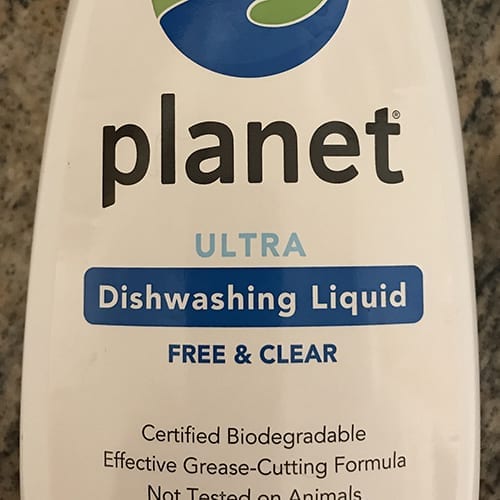
Make wasps a distant memory
Hummingbird enemy #1
You've probably noticed that wasps (aka:yellow jackets) are more aggressive than your hummingbirds. If the wasps find food, they'll aggressively guard it and actually send out a ‘hit wasp’ to chase away any hummingbird who tries to feed. Before you know it, your hummingbird feeder is just a wasp feeder. You get disgusted and take it down. Up or down, the hummingbirds have lost a crucial food source just as they're trying to bulk up for migration.
Don't despair! The raised feeding ports on our feeders discourage wasps so well that they give up after a minute or so. With our feeder, most people find they get one, single 'scout' wasp every now and then. It checks out the feeder and, finding nothing it can access, it leaves. That little scout hasn’t found anything to protect so it doesn’t even chase away the hummingbirds.
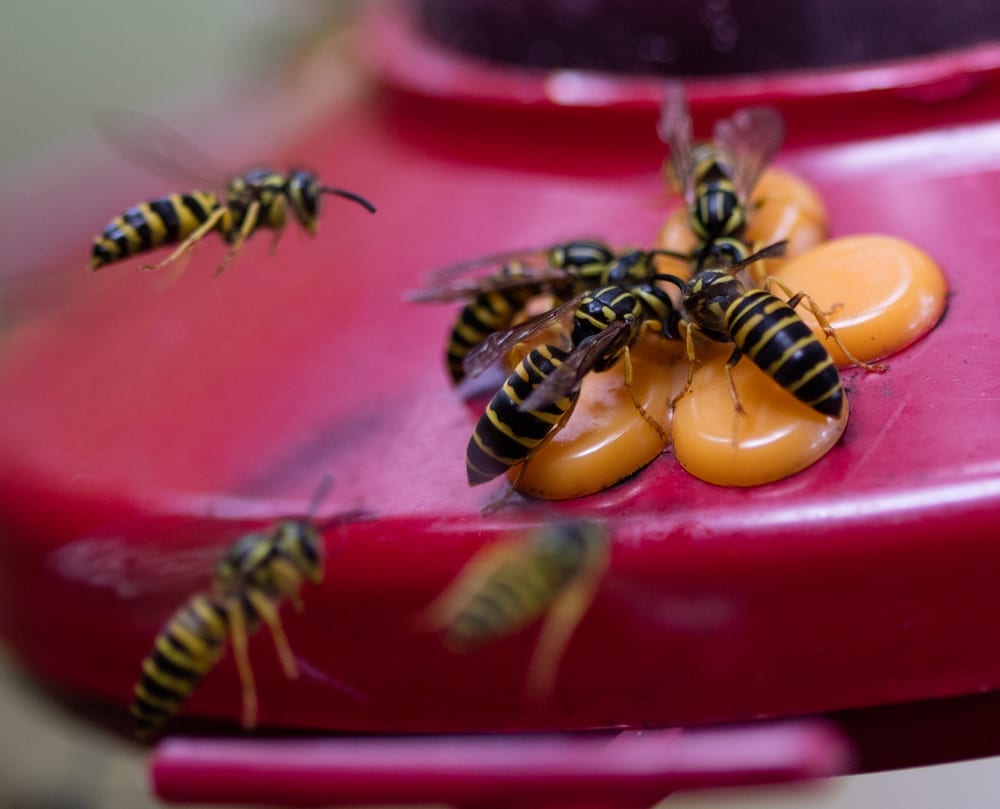
Block Those Ants
Why and how...
Dead/drowned ants are, well... dead bodies. And those little dead bodies pollute the nectar fast. Hummingbirds don't want to, and shouldn't, drink polluted nectar. The large, built-in 'ant moat' on our feeder blocks the ants' access like a charm because ants don't want to cross water. Crazy, eh?
If you're finding ants in your feeder, and you’ve kept the ant moat filled with water, you’ll most likely find one of these situations...
- There’s a leaf, twig, or something within a half inch of some part of the feeder. Ants don’t need a solid bridge. They can cross a small gap using each other as a bridge. It’s crazy. They’ll probably inherit the Earth.
- You’ve got the feeder hanging in a tree. Ants will drop onto your feeder from tree branches, by-passing the ant moat. It's nuts.
- Your neighbor is sneaking over and putting ants in your feeder so they can get back the hummingbirds you stole with your new feeder.
Why CLEAN Water in the Ant Moat??
Hummingbirds, and other small birds, will sometimes drink out of it. Also, ants can cross water if it’s got debris floating in it - like a raft. Who would have thought??!? If you think that's amazing, check out this video, below, of the "Ant Bridge". Be sitting down.
How do you get MORE Hummingbirds?
In addition to all of the above...
- Put your feeder(s) out EARLY. How early?? Too early is best. You don't need a crystal ball. Here's a map that shows the prior years' first sighting dates and the current year, with sightings reported, and updated, daily. Have your feeder waiting for them (before the neighbors do). Click here for the migration map.
- Check out our BLOG: When Should you Put Your Hummingbird Feeder Out in Spring
- Be consistent. Hummingbirds, and their babies, return to the same yard and feeder every year. They remember the exact location of dependable food sources so put the feeder in the same spot as last year.
Environment is the #1 factor for getting lots of hummingbirds. Find out if your yard has what it takes in our upcoming BLOGS: How do YOU get More Hummingbirds. Also, Why do Some People have More Hummingbirds than Others?
Learn Why You may have had Fewer Ruby-Throated Hummingbirds last Year.
Location, Location, Location
Hummingbirds like safety. If possible, locate your feeder in an area with shrubs or trees nearby so they can rest while watching the feeder. It's a good place for them to make sure the coast is clear to your feeder before zooming in. They like pine trees but also other trees, shrubs or foliage. All are better than a wide open area. Shrubs and trees also provide nesting places.
Shade is better for keeping nectar fresh. In some areas, the nectar can actually get too hot from the sun. (Not something we, in Michigan, worry about very much)
You'll find that they'll use your feeder more often if there are trees or shrubs nearby.
For help with strategically locating your feeder, check our future blog:
What's the Best Location for a Hummingbird Feeder?
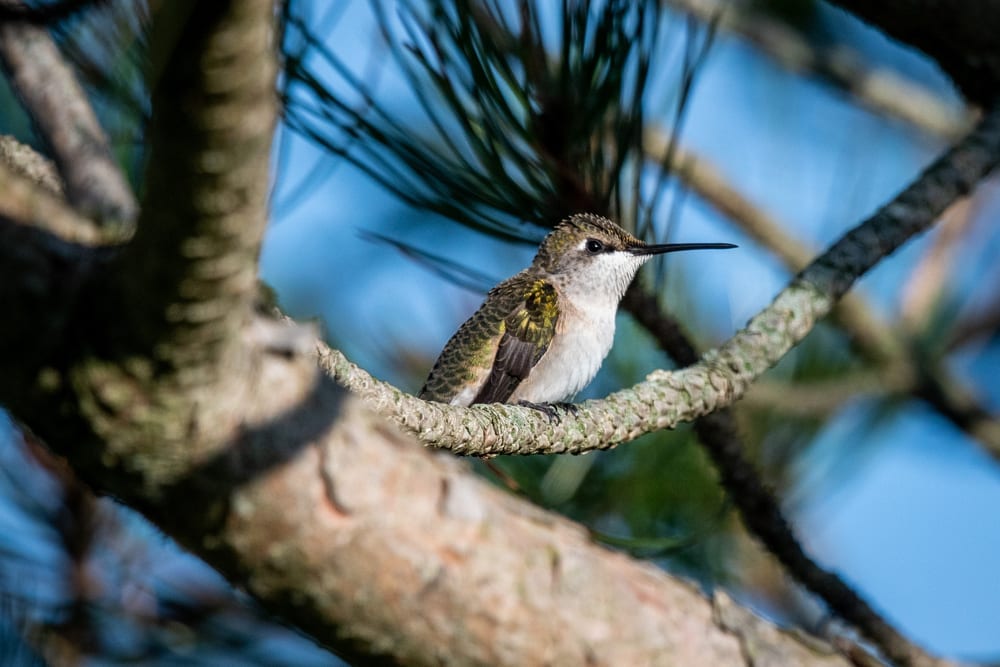
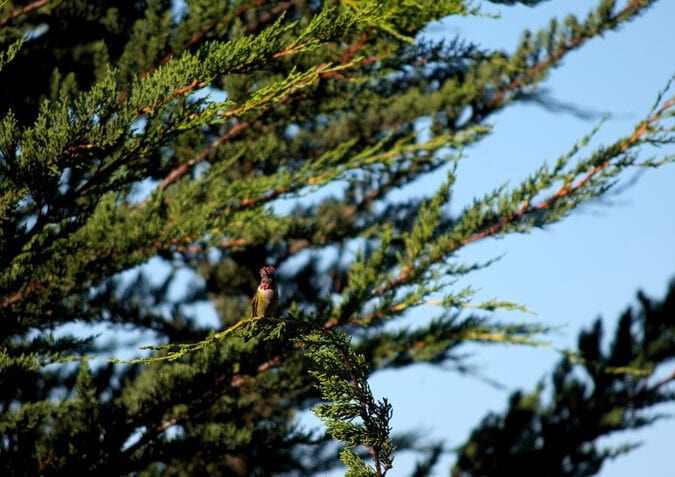
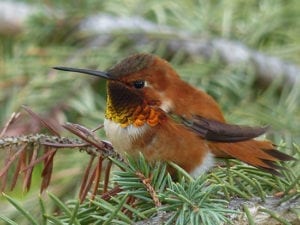
Get them up close
Hummingbirds' incredible flying abilities, combined with their need for calories, makes them very bold. They have no problem coming right up to your window to use your feeder. Many people ask if they can hang a hummingbird feeder under an overhang or porch roof. Yes! In fact, once your hummingbirds find the feeder, you may notice that they actually like prefer feeding under an overhang, especially when it's raining.
You'll find that they get used to your presence. If you're really lucky, you may get a hummingbird hovering right in front of your face. Just stay still and enjoy it. It's an amazing experience.
Hummingbird nests in your yard
In addition to flowers & feeders for food, brush & trees for cover and rest, hummingbirds look for good nesting locations and nearby nesting material. If you'd like to encourage hummingbirds to nest in your yard, there's great information about this in our BLOG, "How to get humming nests in your yard".
Other Things Hummingbirds LIKE:
Hummingbirds also like ponds, fountains, and sprinklers - for drinking, bathing, and also the BUGS... their favorite food! We'll go into more about providing a hummingbird-friendly water feature in our upcoming blog, "Hummingbirds Like Water"
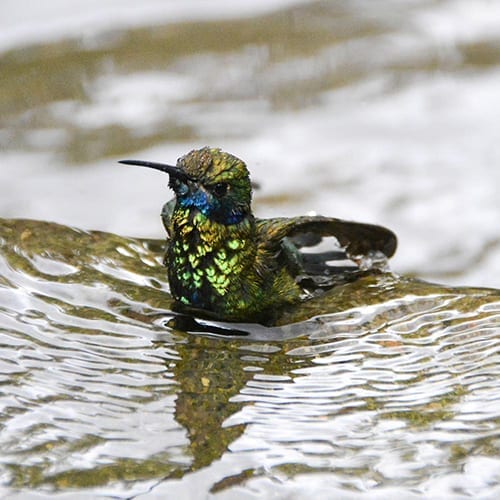
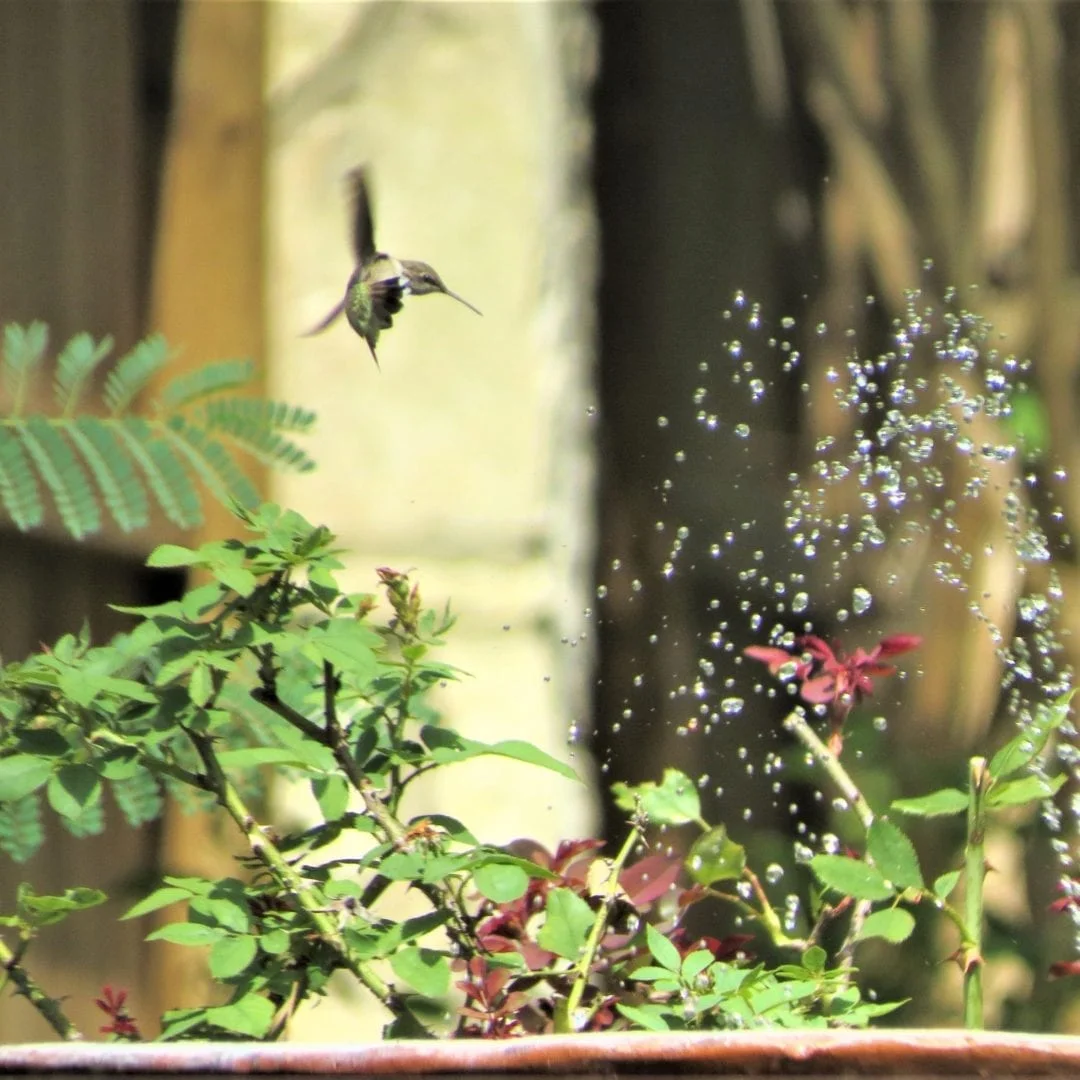
Choosing the BEST feeder
You've made it this far into the website, so this feeder is probably just you've been looking for.
Now you just need to determine which size and style will best suit you and your hummingbirds...
If you're feeding less than a dozen hummingbirds... OR you're feeding hummingbirds for the first time in your yard, we recommend the Lil Sweety feeder. It's our most popular feeder. It's a normal size feeder and is the perfect size for most situations. If you have a bully hummingbird, more feeders are better than one, large feeder. You're not going to convince that bully to share, no matter how huge the feeder.
If you're feeding dozens of hummingbirds... and are refilling your feeders every day, or every other day, the larger XL Hummingbird Feeder feeder may be right for you.
A bigger feeder will not get you more hummingbirds.
It simply accommodates those people who already are feeding dozens of hummingbirds.
If you don't have a place to hang a feeder... our Suction Cup Window Hanger can bring the hummingbirds right up to your window. Handy if you're really near-sighted.
Or place your feeder right IN the garden... The Pole Mount Adapter lets you put your feeder right IN the garden, among your flowers, OR on a stand on a deck or patio. Anywhere you can put a vertical 1" pole, post, pipe, conduit...
F.A.Q.s:
Nope. We use the best plastic available. It's UV stable so it won't fade, get brittle, leak or deteriorate over time. You may want to include it in your will as it'll still be in great shape long after we're all gone. BUT...if it ever does fade, leak or break, we'll replace the offending part, for free. We'll even replace any lost parts for free. Just contact us.
You'll want to attract hummingbirds with flowers and feed them with a feeder. Flowers of all colors attract hummingbirds, especially trumpet-shaped flowers and flowers with nectar. Locate the feeder near the flowers they like and they'll predictably investigate the feeder. Next to the flowers works great. We've got some really interesting information about hummingbirds and the color red in our upcoming blog "Are Hummingbirds Really Only Attracted to Red?"
Yep. Hummingbirds' tongues are twice as long as their beaks. Crazy, eh? So they have no trouble reaching way farther than the bottom of this feeder. And, without dead ants polluting the nectar, don't be surprised if your hummingbirds dry up your feeder.
Hummingbirds are creatures of habit. In order to motivate your hummingbirds to try a new feeder, use the tried & true "Bait & Switch". In order to survive, when hummingbirds find a dependable food source, they stay with it. This is why hummingbirds return to the same yard, and feeder, every year. They remember the location, and appearance, of your old feeder. Keep in mind that it may be the only feeder your hummingbirds have known. When we hang a new and different feeder out, WE know it's a hummingbird feeder but they have no idea that it's anything more than a new yard decoration. So... we use the Bait & Switch method to get them to explore for another food source.
Here's how it works: Hang your old feeder, in it's original location BUT... make sure it's completely EMPTY! Then, hang your new feeder NEXT to it, FULL of fresh, homemade nectar. This way, your hummingbirds, seeing their old, familiar feeder, will not fail to stop at your yard. But, finding that feeder empty, they predictably start checking around for another food source. This works very well because it's actually the way they naturally feed from flowers. Each bloom only has a little nectar each day so, when they finish one bloom, they move to the flower next to it. When they finish with one plant, they start on the plant next to it. So, when they find their old feeder empty, they move to the 'flower' (which is your new feeder) next to it.
Many people incorrectly assume that, because their hummingbirds won't try the new feeder, that they don't 'like' it. It's simply that they don't need to investigate anything else as long as the old feeders are full of nectar - as clearly shown in this video...
Every hummingbird flock has different tolerances and some may take more than a week so be patient. But, truly, almost all of them switch in less than a couple days.
IMPORTANT: When you watch them make the switch, don't worry if you see them try this new feeder briefly then fly away. This is because the feeder they've been using had the nectar right up to the holes so they didn't need to stick out their tongue at all. Just give your hummers a little time to figure out that they'll need to stick out their tongue to get the nectar. That distance keeps out the wasps so it's a good thing. Anyway, it's the natural way that hummingbirds feed from many flowers, especially the large, deep ones. If you're really watching close, you may notice that the males are slower to make the switch. Makes one wonder...
.
.
Excellent question!
In addition to all of the bugs they eat, the answer is pure CANE sugar and water. "Pure granulated sugar" is normally made from sugar beets. Beet sugar is a little less pure, and sweet, than beet sugar plus it has a slight odor. Hummingbirds seem to know the difference. It also doesn't seem to stay fresh as long as cane sugar.
Some people worry that 'refined' sugar is bad for hummingbirds, like we're told it is for humans. On the contrary, it's actually just what they need. Never use "raw" sugar or any sugar with a brownish tint. The brown tint is molasses residue. Molasses is high in iron and iron is very bad for birds. Plus, that molasses residue causes the nectar to go bad very fast and makes a science project in your feeder. Is your well water high in iron? You may want to consider bottled spring water. It's gone through an R.O filter.
If some is good, is more better? Only when you're talking about money. When you're talking about sugar in hummingbird nectar, the answer is a big, fat NO. We go into more detail about this in our blog "What's the Best Food for Hummingbirds?"
What about commercial, 'store-bought' hummingbird nectar??
IF you can find some without preservatives or artificial color... go ahead and use it. But making it yourself is super easy and many customers tell us that their hummies prefer homemade to commercial nectars. Ask yourself... do you prefer fast food or homemade?
Never ever use honey and, obviously, never use artificial sweeteners.
Lastly, never ever use artificial coloring in the nectar! Aside from being totally unnecessary, it's VERY bad for hummingbirds. We mean REALLY bad. Don't even use up the red stuff you still have. Throw it out and spread the word.
It's widely accepted that hummingbird nectar should be changed every 3 to 4 days. This insures fresh nectar for your birds. If the nectar is allowed to go 'bad' by leaving it in the feeder too long, the birds will taste it and likely go look for a better food source, like at the neighbors.
3-4 days is for people with regular feeders. Since our feeders block wasps and ants, the nectar isn't polluted and stays fresh a lot longer than in regular feeders.
There are several factors that cause nectar to go bad faster. #1 on that list is hot sun on it all day. Also, the type of sugar. See the question above, "What is the Best Hummingbird Food?"
Those sugars like "Raw", Organic or other brown-tinted sugars will make a science project in your feeder... then they're off to the neighbors.
Unless you're refilling every, or every other, day, it's a good idea to wash it each time you fill it. You'll find washing this feeder is practically effortless and only takes a few seconds. Even though this feeder is dishwasher safe, you may find that you can get it cleaner washing it by hand, and WAY faster, than the dishwasher that takes, what... an hour??
If you have a regular feeder, use a vinegar & water mixture. If you have one of our feeders, you can use dish soap. Be sure to rinse WELL with COLD water. Cold water rinses soap best. Also, heavily scented dish soaps can leave scent on the feeder. It may smell nice to you but it won't to hummingbirds. Mold should never be allowed to grow in your feeder.
In reality, it took you longer to read all of this than it will take to wash one of our feeders.
You won't be arrested if you do BUT you'll risk getting ants in your feeder. Ants can actually DROP onto the feeder from the tree branches above, bypassing the ant moat. Alas, the ants will probably be here long after we're gone, just due to plain old determination. Isn't there a song about this...?
Each flower only has a small amount of nectar so hummingbirds naturally tend to move from bloom to bloom to bloom so multiple feeding ports are more like 'blooms' for them. If there's a plant with 60 blooms on it, and a plant with 4 blooms on it... which do you think they'll visit first??
Nope. Hummingbirds are unique in that their tongue is crazy long - TWICE as long as their beaks! So only hummingbirds can reach the nectar in our feeders. Other birds, who typically will drain regular hummingbird feeders, can't reach the nectar in this feeder. And because our special plastic is so hard, Orioles, even woodpeckers, can't peck out and enlarge the holes so they can't access the nectar. It can be entertaining to watch them try, though. They give up and sometimes take a drink from the ant moat, like a consolation prize.
Sounds like free entertainment for you because we'll replace the lid at no cost. You don't even need to send us a picture of the racoon.
See??? Even bears love it! No need to buy another feeder. This feeder is incredibly strong but bears are stronger. We'll send you a new feeder, at no cost. Please don't send us any pieces of the feeder you've found. May we suggest that you locate your feeder away from the house? We're thinking like 5 miles.
Not the first time this has happened. It looks pretty high tech. No worries, we'll send you a new lid. Makes one wonder if we'll someday see a UFO that looks like our hummingbird feeder. Do you happen to live in New Mexico?
We have made the best, and toughest, feeder possible. We will replace any broken or lost part for the rest of your life - and the life of the person you willed it to.
Good news.... if the tab, that keeps the feeder on the hanger, no longer holds up the feeder, just let us know and we will ship you our Gen II nectar bowl and hanger. Just send us a message on the "Contact us" page. We'll need to know if you have the large, Hum Sweet Hum or the Lil Sweety feeder. Please include an address to which we can ship parts.
